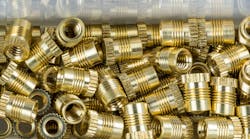This article was updated May 25, 2023. It was originally published Nov. 17, 2009.
To put hard, durable threaded holes in plastics, engineers often specify threaded metal inserts that will securely hold fasteners and reinforce joints. Though stainless-steel inserts may work well, using them is often overkill and unnecessary. Brass inserts, on the other hand, meet most performance requirements and offer significant cost benefits compared to steel.
Raw material costs for brass and stainless steel are typically similar but it costs much more to machine stainless steel. Free-machining stainless steel may only be 40 to 50% as efficient to machine as brass. And other austenitic stainless steels may be less than 40% as efficient to machine. One aspect of stainless steel’s lower machinability is that it is a poor conductor of heat compared to brass. This raises temperatures during machining and reduces the life of cutting tools.
Brass scrap created during machining can be sold with a minimal loss in value. In contrast, stainless-steel scrap retains little of its initial value, which is another reduction in overall efficiency.
Machined inserts can be installed using several different methods, though post-mold heat installation is the most common. Inserts can be heated several ways: charged directly using heated tips or chimneys, or indirectly with ultrasonic energy. In both methods, the insert must be heated to at least the plastic’s melting point.
A mentioned earlier brass is much better conductor of heat than stainless steel or carbon steel. In fact, it’s twice as conductive as carbon steel and 15 times more conductive than austenitic stainless steel. This allows more rapid heating and cooling when installing them in thermoplastics using heat, and this improves cycle time.
More rapid dissipation of heat also improves the insert’s positional accuracy. Rapid cooling prevents a condition commonly referred to as “float.” It arises when inserts remain hot after the tips or ultrasonic horn have been removed and the inserts move slightly. With fast cooling, the plastic sets quickly and fixes the insert accurately in position and depth.
Brass Benefits
Brass offers significant advantages over stainless steel, so it is preferred for most industrial and agricultural applications. But there are applications which require stainless steel. For example, brass and stainless steel both resist corrosion, but they react differently to various corrosive agents, so steel may get the nod in some instances.
Here’s a closer look at some of brass’ advantages:
- Well suited for industrial/residential hot- and cold-water systems, including those carrying potable water.
- Withstands some marine environments including brackish water and seawater with moderate currents. Brass exposed to the sea develops a protective green patina.
- Performs well in cryogenic applications, making it an alternative to 300 Series stainless steel in some environments.
- Typically handles exposure to mild alkaline solutions, though strong solutions such as hydroxides and cyanides should be avoided.
- Resists corrosion in nonoxidizing acids. Oxidizing acids should be avoided.
- Strength is good; overlaps the tensile strength of 12L14 low-carbon steel.
- Can be nickel plated to reduce tarnishing and corrosion or to provide a “silver” finish. Nickel finishes can also put a hard-wearing surface on products such as gears, bearings and plumbing fixtures.
Stainless Steel
300 Series and austenitic stainless steels are the most commonly used steel alloys for inserts, though many of the could also be used.
Among stainless steel’s advantages:
- Certain grades, such as 316, are more durable than brass in more-aggressive marine environments such as fast-moving currents, but this does not apply to all grades. The most common turning stainless, free-machining 303, contains added sulfur that gives it better machinability than other 300 Series stainless steels. Conversely, sulfur significantly decreases corrosion resistance in seawater. Brackish or slow-moving seawater may also increase crevice or pitting corrosion in various grades.
- Excellent resistance to petroleum products and many acids (excepting hydrochloric acids); it can be passivated in citric or nitric acid solutions.
- It is typically stronger than brass.
- Certain grades of austenitic stainless steel such as 302, 304 and 316 are FDA-approved for food contact, and a good choice for food and beverage applications. Free-machining 303 stainless steel, however, is not approved for use in contact with food.
- Austenitic stainless steel withstands higher temperatures than brass, but few applications can take advantage of that fact. The plastic component in which the insert is to be placed would likely melt when exposed to such high temperatures. The service temperatures for most plastic assemblies are within the acceptable service temperature for brass.
RELATED
Putting Inserts in Plastic Parts: Ultrasonic or Heat?
The Fredsert: a Threaded Insert Tough Enough for the Marines
Michael Pasko was an application engineer at Spirol when this article was originally published.
